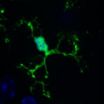(Press-News.org) COLUMBUS, Ohio – Scientists have identified a family of proteins that close a critical gap in an enzyme that is essential to all life, allowing the enzyme to maintain its grip on DNA and start the activation of genes.
The enzyme, called RNA polymerase, is responsible for setting gene expression in motion in all cells. RNA polymerase wraps itself around the double helix of DNA, using one strand to match nucleotides and make a copy of genetic material.
RNA polymerase cannot fall off of the DNA or stop this process once it starts. If it does, no proteins will be made, and the cell will die.
A team led by Ohio State University researchers demonstrated in a bacterial model that a specific protein binds to two sides of a space in the RNA polymerase molecule at a critical point in its connection to DNA, effectively closing the gap and creating a clamp around the two strands.
In bacteria, two related proteins perform this function. One is NusG, which is required for bacterial growth. Another is RfaH, a virulence factor that gives bacteria their ability to infect and cause disease. Depending on the gene, either NusG or RfaH bridges the critical gap in RNA polymerase in bacteria to maintain the enzyme's attachment to DNA, the researchers found.
"DNA could be imagined as a cylinder, and RNA polymerase encircles it," said Irina Artsimovitch, associate professor of microbiology at Ohio State and senior author of the research. "Before, we had a structural model where these proteins sit at a site where RNA polymerase contacts the DNA. But even if you see something binding, you still have to prove this binding has a functional consequence. We show here that RNA polymerase forms two halves of a clamp, and these proteins bind in the middle and make the clamp complete."
Though understanding this mechanism was the main goal of the study, the findings could contribute to research in antibiotic development. With these proteins known to have a critical role in supporting cell life, they could function as targets for drugs designed to either kill bacteria or take away their ability to cause disease.
The research is published in the July 22, 2011, issue of the journal Molecular Cell.
RNA polymerase is an unusual enzyme because of its processivity, a quality that both requires and enables it to do its extremely long and complicated job perfectly every time, without pausing or making a mistake. Scientists have known that RNA polymerase is processive, but until now didn't know how it remained so. Because RNA polymerase is universally conserved – meaning it is present and has the same function in all living organisms and has for generations – these findings in bacteria apply to all other forms of life, including humans.
"RNA polymerase has to make very long messages. In humans, RNA chains can be up to 1 million nucleotides long. If RNA polymerase stops prematurely, it loses the RNA chain and has to start over again. To prevent this futile cycle, some factor has to help RNA polymerase to stay bound to the DNA and RNA," Artsimovitch said. "Our major argument is that RNA polymerase can run longer if it makes a ring around the DNA."
Artsimovitch pursued the roles of RfaH and NusG because these proteins, too, are universally conserved, just as the RNA polymerase enzyme is. In other single-celled and also more complex organisms, they have different names than those found in bacteria, but their roles as transcription factors – proteins that control gene expression – are the same. And they are the only family of transcription factors known to be universally conserved.
"It makes sense – if something is universally conserved, it is likely doing something very important," said Artsimovitch, also an investigator in Ohio State's Center for RNA Biology.
She and colleagues conducted a series of genetic and biochemistry experiments in cells and test tubes, respectively, to define the roles of the RfaH and NusG proteins in Escherichia coli, their model system. Their findings helped confirm recent reports from other researchers studying single-celled Archaea organisms suggesting that the structures of these proteins allow them to close the clamp on RNA polymerase and contribute to its processivity.
There is additional context from Artsimovitch's work, however, that determines which protein fills the gap.
"So we know the mechanism by which these proteins work is similar in all organisms, but you can have different scenarios," said Anastasia Sevostyanova, a postdoctoral researcher in microbiology at Ohio State and first author of the study.
In most cases, a bacterial cell needs to turn on genes just so it can continue to grow. In those cases, NusG would close the gap. However, under circumstances when specialized control of genes is in order – such as when bacteria infect their human host – then RfaH, the virulence factor, will fill that gap in the RNA polymerase clamp instead.
The researchers hope to further elucidate how other factors from the same universally conserved family of proteins orchestrate the gene expression programs that control cell life.
###
This work was supported by grants from the National Institutes of Health.
Study co-authors include Georgiy Belogurov, formerly of Ohio State's Department of Microbiology and now with the University of Turku in Finland; and Rachel Mooney and Robert Landick of the University of Wisconsin-Madison.
Contact: Irina Artsimovitch, (614) 292-6777; Artsimovitch.1@osu.edu or Anastasia Sevostyanova, (614) 688-3561; Sevostiyanova.1@osu.edu
Written by Emily Caldwell, (614) 292-8310; Caldwell.151@osu.edu
Proteins enable essential enzyme to maintain its grip on DNA
2011-07-22
ELSE PRESS RELEASES FROM THIS DATE:
UNC researchers identify seventh and eighth bases of DNA
2011-07-22
(Embargoed) CHAPEL HILL – For decades, scientists have known that DNA consists of four basic units -- adenine, guanine, thymine and cytosine. Those four bases have been taught in science textbooks and have formed the basis of the growing knowledge regarding how genes code for life. Yet in recent history, scientists have expanded that list from four to six.
Now, with a finding published online in the July 21, 2011, issue of the journal Science, researchers from the UNC School of Medicine have discovered the seventh and eighth bases of DNA.
These last two bases – called ...
Working mothers and the effects on children
2011-07-22
Parents struggling to combine paid work with bringing up their children now have some positive news thanks to a new study funded by the Economic and Social Research Council (ESRC) on maternal employment and child socio-emotional behaviour in the UK. The research shows that there are no significant detrimental effects on a child's social or emotional development if their mothers work during their early years.
The ideal scenario for children, both boys and girls, was shown to be where both parents lived in the home and both were in paid employment. For children living with ...
Gardening in the brain
2011-07-22
Gardeners know that some trees require regular pruning: some of their branches have to be cut so that others can grow stronger. The same is true of the developing brain: cells called microglia prune the connections between neurons, shaping how the brain is wired, scientists at the European Molecular Biology Laboratory (EMBL) in Monterotondo, Italy, discovered. Published online today in Science, the findings could one day help understand neurodevelopmental disorders like autism.
"We're very excited, because our data shows microglia are critical to get the connectivity ...
Identical virus, host populations can prevail for centuries, WHOI researcher reports
2011-07-22
A Woods Hole Oceanographic Institution (WHOI) scientist, analyzing ancient plankton DNA signatures in sediments of the Black Sea, has found for the first time that the same genetic populations of a virus and its algal host can persist and coexist for centuries. The findings have implications for the ecological significance of viruses in shaping algae ecosystems in the ocean, and perhaps fresh water as well.
"The finding that the DNA of viruses and algal host cells can be preserved in the geological records is of great interest to microbial ecologists," said Marco Coolen ...
Plan to one day end the use of environmentally harmful chemicals on commercial crops developed
2011-07-22
(Edmonton) Two University of Alberta researchers have published a step by step plan to one-day end the use of environmentally harmful chemicals on commercial crops by developing plants that produce their own fertilizer.
U of A plant biologist Allen Good says the energy required to produce nitrogen fertilizers has pushed the world-wide cost for agricultural producers to a $100 billion a year. Good says that while they are necessary for high yields, those nitrogen fertilizers also damage the environment. Emissions from nitrogen fertilizers add to greenhouse gas emissions ...
Repairing our inner clock with a 2-inch fish
2011-07-22
Tel Aviv — Circadian rhythms — the natural cycle that dictates our biological processes over a 24-hour day — does more than tell us when to sleep or wake. Disruptions in the cycle are also associated with depression, problems with weight control, jet lag and more. Now Prof. Yoav Gothilf of Tel Aviv University's Department of Neurobiology at the George S. Wise Faculty of Life Sciences is looking to the common zebrafish to learn more about how the human circadian system functions.
Prof. Gothilf and his Ph.D. student Gad Vatine, in collaboration with Prof. Nicholas Foulkes ...
Washing away good and bad luck
2011-07-22
RIVERSIDE, Calif. (www.ucr.edu) -- Do people believe good and bad luck can be washed away?
Yes, according to an advanced online publication in the Journal of Experimental Psychology that was co-authored by Rami Zwick, a University of California, Riverside marketing professor in the School of Business Administration.
Zwick, working with Alison Jing Xu of the University of Toronto, and Norbert Schwarz of the University of Michigan, designed two experiments that showed risk taking depends on whether participants recalled a past episode of good or bad luck and whether they ...
Do we buy cosmetics because they are useful or because they make us feel good?
2011-07-22
A study by the University of the Basque Country (UPV/EHU) shows that people who use cosmetics buy these products primarily for emotional reasons. The study was carried out on facial creams (hydrating and nutritive ones, coloured or non-coloured, and anti-wrinkle creams) and body creams (firming and anti-cellulite creams).
"The study shows that both the emotional and utility aspect of cosmetic brands have a significant impact on consumer satisfaction, but that the emotional component has a greater effect", Vanessa Apaolaza, a researcher from the UPV and lead author of ...
A new discovery paves the way for using super strong nanostructured metals in cars
2011-07-22
Today, the body of an ordinary family car consists of 193 different types of steel. The steel for each part of the car has been carefully selected and optimised. It is important, for example, that all parts are as light as possible because of the fuel consumption, whereas other parts of the car have to be super strong in order to protect passengers in a collision.
Super strong nanostructured metals are now entering the scene, aimed at making cars even lighter, enabling them to stand collisions in a better way without fatal consequences for the passengers. Research into ...
University of Leicester develops test for classifying force used in bottle stabbings
2011-07-22
Engineers at the University of Leicester have for the first time created a way of measuring how much force is used during a stabbing using a broken bottle. The advance is expected to have significant implications for legal forensics.
A team from the University has conducted a systematic study of the force applied during a stabbing and come up with the first set of penetration force data for broken glass bottles. This work has been published in the International Journal of Legal Medicine (http://www.springerlink.com/content/v21t5g05250n22xw/)
Stabbing is the most ...



